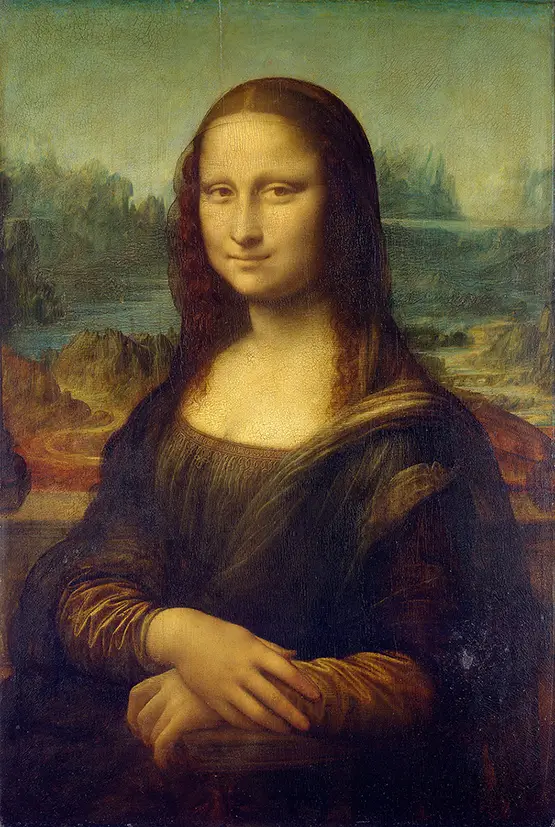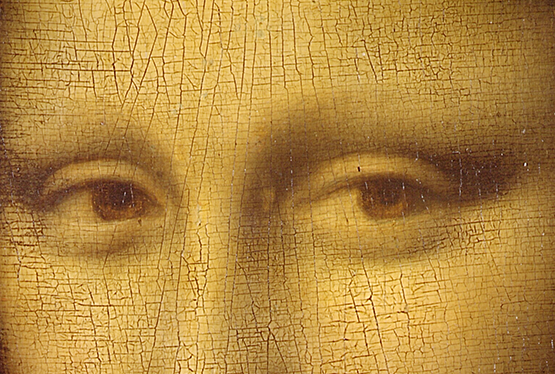Mona Lisa (La Gioconda)
Name: Mona Lisa (La Gioconda) |
|
Painter: Leonardo da Vinci |
|
Subject: Lisa del Giocondo |
|
Location: Louvre, Paris |
|
Years: c. 1503 - 1517 |
|
Size: 30 × 21 in (77 × 53 cm) |
|
| Mona Lisa Facts | Mona Lisa Pics | Paintings |
The Mona Lisa is a half-length portrait unfinished painting by Italian artist Leonardo da Vinci. A masterpiece of the Italian Renaissance, it is the most famous, the most visited, the most valuable work of art in the world. The iconic painting's novel qualities include the subject's enigmatic expression, monumentality of the composition, the subtle modelling of forms, and the atmospheric illusionism.
The painting has been traditionally considered to depict Lisa del Giocondo, the wife of a wealthy Florentine merchant, Francesco del Giocondo. It is painted in oil on a white poplar panel. Leonardo never gave the painting to the Giocondo family. It was believed to have been painted between 1503 and 1506, with some sources suggesting da Vinci continued refining it until 1517. Leonardo da Vinci's painting skills wore away by the year 1517 as he suffered nerve damage to his right hand after fainting, which may indicate why he left the Mona Lisa unfinished.
King Francis I of France acquired the Mona Lisa after Leonardo's death in 1519, and it is now the property of the French Republic. It was kept at the Palace of Fontainebleau until Louis XIV moved it to the Palace of Versailles, where it remained until the French Revolution. After the French Revolution, the painting was moved to the Louvre, but spent a brief period in either the bedroom or state room of Napoleon in the Tuileries Palace. It has normally been on display at the Louvre in Paris since 1797. At Louvre, the Mona Lisa is displayed in a specially designed, climate-controlled case behind bulletproof glass. The temperature is kept between 18°C (64°F) and 21°C (70°F), and the case includes a layer of silica gel to maintain a relative humidity of 55%. The painting is illuminated by a 20-watt LED lamp that was specially designed for this painting. The lamp has a Colour Rendering Index of up to 98 and minimizes infrared and ultraviolet radiation, which could otherwise degrade the painting.
The Mona Lisa became globally famous in part due to its theft in 1911 by Vincenzo Peruggia, which drew worldwide attention to what was, at the time, a relatively unknown painting. The theft and its recovery in 1914 sparked massive publicity, turning the Mona Lisa into a household name.
The Mona Lisa is celebrated for its realism, especially in how da Vinci captured the play of light and shadow, known as "sfumato," to create soft transitions between colors and forms. This technique gives the painting its lifelike, almost three-dimensional quality. The subject's enigmatic smile and her steadfast gaze, thought to follow the viewer around the room, has added to the painting’s intrigue.
The painting has been traditionally considered to depict Lisa del Giocondo, the wife of a wealthy Florentine merchant, Francesco del Giocondo. It is painted in oil on a white poplar panel. Leonardo never gave the painting to the Giocondo family. It was believed to have been painted between 1503 and 1506, with some sources suggesting da Vinci continued refining it until 1517. Leonardo da Vinci's painting skills wore away by the year 1517 as he suffered nerve damage to his right hand after fainting, which may indicate why he left the Mona Lisa unfinished.
King Francis I of France acquired the Mona Lisa after Leonardo's death in 1519, and it is now the property of the French Republic. It was kept at the Palace of Fontainebleau until Louis XIV moved it to the Palace of Versailles, where it remained until the French Revolution. After the French Revolution, the painting was moved to the Louvre, but spent a brief period in either the bedroom or state room of Napoleon in the Tuileries Palace. It has normally been on display at the Louvre in Paris since 1797. At Louvre, the Mona Lisa is displayed in a specially designed, climate-controlled case behind bulletproof glass. The temperature is kept between 18°C (64°F) and 21°C (70°F), and the case includes a layer of silica gel to maintain a relative humidity of 55%. The painting is illuminated by a 20-watt LED lamp that was specially designed for this painting. The lamp has a Colour Rendering Index of up to 98 and minimizes infrared and ultraviolet radiation, which could otherwise degrade the painting.
The Mona Lisa became globally famous in part due to its theft in 1911 by Vincenzo Peruggia, which drew worldwide attention to what was, at the time, a relatively unknown painting. The theft and its recovery in 1914 sparked massive publicity, turning the Mona Lisa into a household name.
The Mona Lisa is celebrated for its realism, especially in how da Vinci captured the play of light and shadow, known as "sfumato," to create soft transitions between colors and forms. This technique gives the painting its lifelike, almost three-dimensional quality. The subject's enigmatic smile and her steadfast gaze, thought to follow the viewer around the room, has added to the painting’s intrigue.
Leonardo developed the technique of sfumato, a subtle way of dealing with light and shade through the blurring of tones and colors. Sfumato is a painting technique that uses subtle gradations of color and tone to create a smoky, atmospheric effect. (sfumato means smokysfumato is an Italian word that means "smoky"). He blended the edges of the subjects’s lips into her skin in a natural and lifelike way.
Mona Lisa has no clearly visible eyebrows or eyelashes. High resolution scans of the painting provide evidence that Mona Lisa was originally painted with eyelashes and eyebrows, but that these had gradually disappeared over time, perhaps as a result of overcleaning. The painting had been reworked several times, with changes made to the size of the face and the direction of gaze.
The enigmatic woman is portrayed seated in what appears to be an open loggia with dark pillar bases on either side. Behind her, a vast landscape recedes to icy mountains, winding paths and a distant bridge. Around 1505, Italian painter Raphael executed a pen-and-ink sketch, in which the columns flanking the subject are more apparent. Experts universally agree that the sketch is based on Mona Lisa painting. The Mona Lisa has had many different decorative frames in its history. In 1909, the art collector Comtesse de Béhague gave the portrait its current frame.
In 1859, French poet Théophile Gautier wrote that the Mona Lisa was a "sphinx of beauty who smiles so mysteriously" and that "Beneath the form expressed one feels a thought that is vague, infinite, inexpressible. One is moved, troubled ... repressed desires, hopes that drive one to despair, stir painfully."
In 1859, French poet Théophile Gautier wrote that the Mona Lisa was a "sphinx of beauty who smiles so mysteriously" and that "Beneath the form expressed one feels a thought that is vague, infinite, inexpressible. One is moved, troubled ... repressed desires, hopes that drive one to despair, stir painfully."
From December 1962 to March 1963, the French government lent it to the United States to be displayed in New York City and Washington, D.C. It was shipped on the ocean liner SS France. In 1974, the painting was exhibited in Tokyo and Moscow.
Today, the Mona Lisa is considered priceless and is viewed by about 10 million visitors annually. It continues to be a subject of extensive scholarly research, artistic admiration, and popular culture references, cementing its status as a timeless masterpiece of human art.
Today, the Mona Lisa is considered priceless and is viewed by about 10 million visitors annually. It continues to be a subject of extensive scholarly research, artistic admiration, and popular culture references, cementing its status as a timeless masterpiece of human art.




